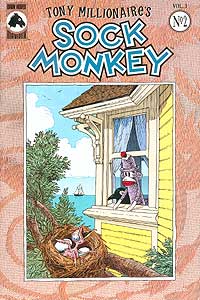
|
Like a lot of children's literature, these stories — sometimes spanning two issues — feature beloved objects that have come to life. The titular sock-monkey, named Uncle Gabby, and Mr. Crow, a cloth crow with button eyes, get into adventures by innocently imitating the adult world. The stories read like original Grimm's fairy tales — the ones where Cinderella's stepsisters hack away at their feet with an ax so they will fit the glass slipper. They have a romantic, quaint naïveté mixed with moments of modern existential horror.
In the latest issue Uncle Gabby discovers a baby bird outside his window. Already something seems wrong. The baby bird looks and acts like a real baby bird. It doesn't talk or look cute. Anne-Louise, the little girl who takes care of Uncle Gabby and Mr. Crow, warns them against playing with it. But Uncle Gabby really thinks the bird will get a kick out of his new toy, Chinese Handcuffs. Soon the poor thing plummets to its death.
Suddenly it feels like a Bergman film. Tormented by guilt, Uncle Gabby wanders the beautiful countryside for several silent pages until he can take no more. Slowly he plunges a pair of scissors into his soft head so that the stuffing spills out. The Millionaire touch of exquisite ghastliness comes when this fails to kill, and instead leaves him to ponder life as a "soulless monster." Thankfully, in an oddly uplifting ending, the little girl sews him up and puts him to bed with forgiveness.
If it weren't for the schadenfreude you expect with each turn of the page, the pictures would be called "charming." Millionaire once made his living as an architectural artist, sketching people's houses. In fact, much of "Sock Monkey" involves a love of still-lives, usually including Victorian-era ephemera. The panels are often extra-large to accommodate these precise black-and-white drawings, which have the quality of etchings.
It's partly this drafting skill and design sense that make it hard to dismiss "Sock Monkey" as something pointlessly ironic. The other part is Millionaire's talent for language. Characters have a strange, arched sort of "voice," unlike any I've experienced. At one point Mr. Crow says, "Why is it that I am the only bird on the American scene who cannot fly?" It's that "on the American scene" that gets me. Such stylings have a stilted delicacy that perfectly matches the art.
There's something enigmatic about the series; you never know what to make of "Sock Monkey." Is it for kids? Is it satire? Is it sincere? Is it a metaphor? Is it meant to be funny? Once you accept the answer to all these questions is "yes and no," you can enjoy the head-space it puts you in.
The first four issues of "Sock Monkey" have been collected as a trade paperback. The collection and the individual issues can be purchased at superior comic book stores, but call first. Tony Millionaire also has a collection of his weekly series, "Maakies," available at better book stores and comic shops, as well as a website: www.maakies.com.
